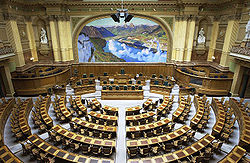Bundesversammlung (Switzerland)
|
Federal Assembly |
|
|---|---|
 |
|
| Type | |
| Type | |
| Houses |
Council of States National Council |
| Leadership | |
|
President of the National Council
|
|
|
President of the Council of States
|
|
| Structure | |
| Seats |
246 200 National Council 46 Council of States |
 |
|
|
National Council political groups
|
Government parties (169) Opposition parties (31)
|
 |
|
|
Council of States political groups
|
Government parties (43) |
| Elections | |
|
National Council last election
|
18 October 2015 |
|
Council of States last election
|
18 October, 15 and 22 November 2015 |
| Meeting place | |
 |
|
| Federal Palace of Switzerland, Bern | |
| Website | |
| www |
|
Government parties (169)
Opposition parties (31)
Government parties (43)
The Federal Assembly (German: Bundesversammlung, French: Assemblée fédérale, Italian: Assemblea federale, Romansh: Assamblea federala), is Switzerland's federal legislature. It meets in Bern in the Federal Palace.
The Federal Assembly is bicameral, being composed of the 200-seat National Council and the 46-seat Council of States. The houses have identical powers. Members of both houses represent the cantons, but, whereas seats in the National Council are distributed in proportion to population, each canton has two seats in the Council of States, except the six 'half-cantons' which have one seat each. Both are elected in full once every four years, with the last election being held in 2015.
The Federal Assembly possesses the federal government's legislative power, along with the separate constitutional right of citizen's initiative. For a law to pass, it must be passed by both houses. The Federal Assembly may come together as a United Federal Assembly in certain circumstances such as to elect the Federal Council (collective executive head of government and state), the Federal Chancellor, the federal judges or a General (only in times of great national danger).
...
Wikipedia
